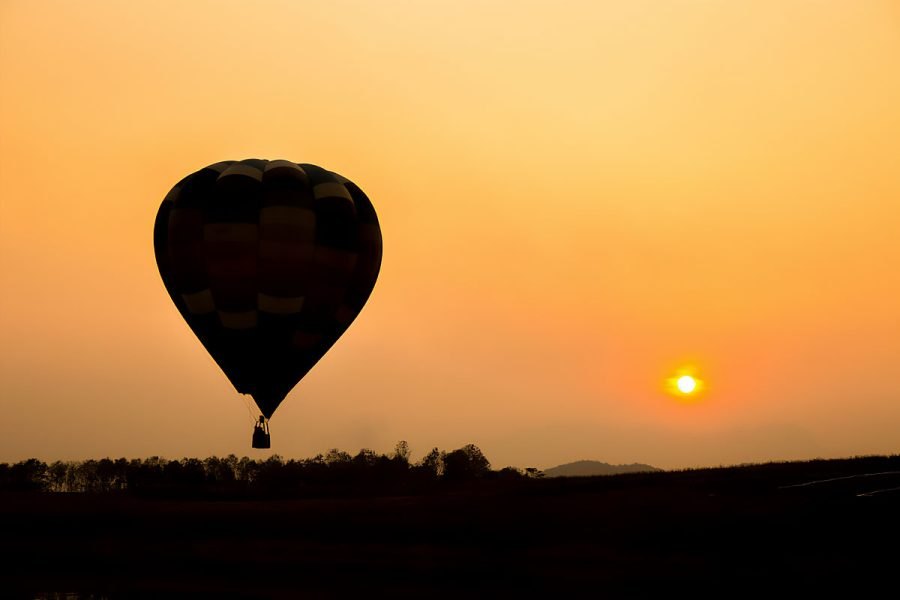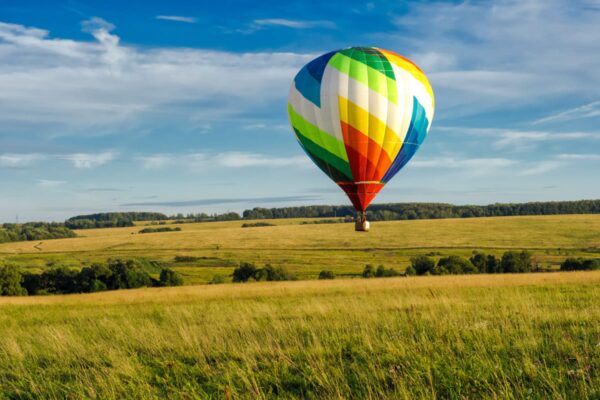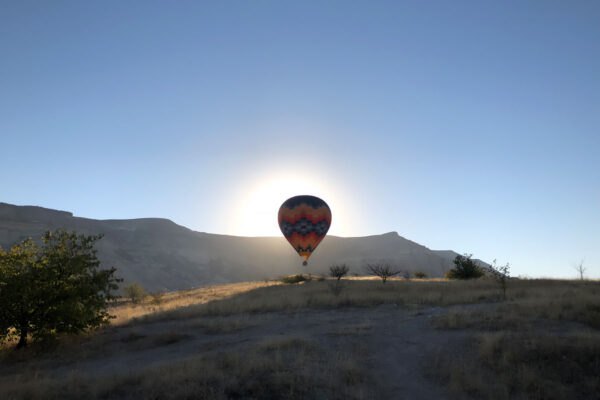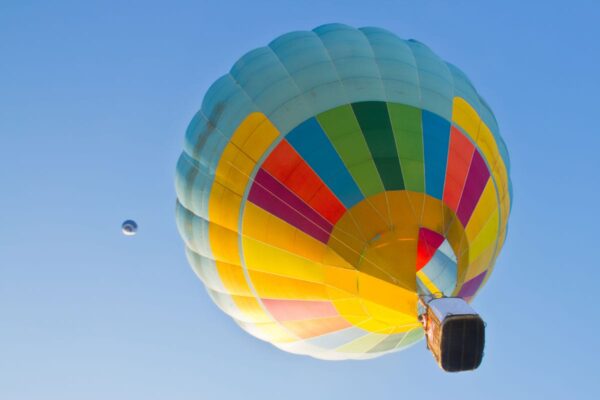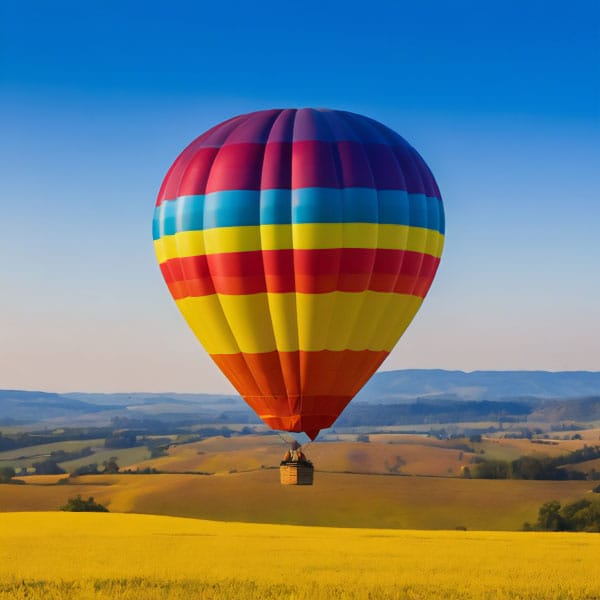Balloon flights are an extraordinary experience that allows you to see the world from a completely different perspective. Hovering in the skies gives a sense of freedom and peace. However, people interested in this form of spending time often notice a certain regularity – balloons take off mainly at sunrise or sunset. This is not a coincidence or whim of pilots. There are specific reasons behind this phenomenon related to the physics of flight and passenger safety.
The time of day is crucial for air stability. During sunrise and sunset, atmospheric conditions are usually most favorable for balloons. The air is calmer then and the wind is predictable. During the day, the sun warms the ground, leading to rising currents called thermals. These invisible columns of warm air can make balloon control significantly more difficult.
Flights at dawn have their own unique charm – the waking day, the first rays of the sun illuminating the landscape, the morning dew on the fields. Sunset flights, on the other hand, offer spectacular views of skies shimmering in shades of red, orange and purple. Each of these seasons has its own advantages and provides a different aesthetic experience. The choice between them depends on individual preferences and time possibilities.
Air stability a key factor for safe balloon flights
The stability of the atmosphere plays a fundamental role in ballooning. The air must be predictable and calm for a safe flight. A stable layer of air near the surface of the earth allows precise control of the balloon and control of its altitude.
Why does stability matter?
A hot air balloon floats on the principle of density difference. As the air inside the balloon is heated by the burner, it becomes lighter than the surrounding cooler air, causing it to rise. The pilot controls the altitude by adjusting the temperature inside the canopy. Under stable atmospheric conditions, this process is predictable and safe.
In the morning and evening, the air is stratified into layers of different temperatures, which do not mix intensively. This stratification of the air promotes smooth flight. The lack of rapid air movement allows for precise maneuvering and altitude control.
A stable layer of air near the ground is calleda “ground inversion” in meteorology. It occurs most often just at sunrise and sunset, when the temperature near the ground is lower than in the higher layers of the atmosphere.
Effect of time of day on atmospheric stability
Sunrise and sunset are transitional moments in the diurnal cycle of heating and cooling of the atmosphere. In the morning, the air is still cool after a night’s sleep, and in the evening it begins to cool after heating all day. In both cases, the temperature differences between air layers are smaller than during the day.
The stability of the air can be assessed by several factors:
- Wind speed near the ground surface
- The direction of the wind at different heights
- Temperature gradient (temperature change with altitude)
- The presence of convective clouds
Balloon pilots analyze these parameters before each flight, using professional meteorological instruments and weather forecasts. Passenger safety is always a priority, which is why flights are canceled if conditions do not meet strict standards.
How do pilots assess air stability?
Experienced pilots are able to assess atmospheric stability by observing their surroundings. Before takeoff, they often release a small helium-filled balloon (known as a pibal) to check the direction and strength of the wind at different altitudes. Observing the behavior of clouds also provides valuable information about air movements.
Professional ballooning companies use advanced meteorological tools that provide precise data on atmospheric conditions. Forecasts are checked several times before each flight, and the final decision to take off is often made shortly before the planned ascent.
The stability of the air affects not only safety, but also flight comfort. In calm air, the balloon moves smoothly, without sudden movements, allowing passengers to fully enjoy the extraordinary views and atmosphere of the flight.
Thermals during the day make it difficult to control the balloon
Thermals are an atmospheric phenomenon involving the formation of vertical ascending currents. It mainly occurs during the day when the sun intensely heats the ground surface. Different types of ground heat up unevenly, leading to the formation of columns of warm air.
Mechanism of formation of thermals
The sun heats the ground, which in turn gives off heat to adjacent layers of air. The warm air, being lighter, begins to rise, forming vertical upward currents. These columns of warm air can reach upwards of several kilometers. Between them are areas of descending, cooler air.
Thermals are particularly intense over surfaces that heat up quickly, such as:
- Asphalt and concrete
- Cultivated fields after harvesting
- Sandy areas
- Sunny mountain slopes
Over forests, lakes and wetlands, thermals are weaker because these areas are slower to heat up and release heat.
Effect of thermals on balloon flight
For a balloon, thermals pose a serious challenge. When a balloon flies into an area of rising current, it can rapidly increase altitude. On the other hand, when flying into an area of descending air, it can begin to lose altitude rapidly. These sudden changes make it difficult for the pilot to control the balloon.
Thermals cause deformation of the balloon’s canopy. Uneven heating of the air inside and outside the balloon can lead to changes in the shape of the canopy, which affects aerodynamics and flight stability. In extreme cases, this can lead to dangerous situations.
Interesting fact: Gliders use thermals to ascend without the use of an engine. Glider pilots specifically seek out areas of thermals, while balloon pilots try to avoid them.
Why are midday flights avoided?
During the midday hours, when the sun is at its highest, thermals reach their maximum intensity. This is when the air is most unstable and the updraft currents are strongest. In addition, the wind often changes direction and speed during the day, making it even more difficult to predict a flight path.
Flying at midday would also require more gas consumption, as the pilot would have to use the burner more often to compensate for the impact of thermals. This, in turn, would reduce flight time and increase operating costs.
How does thermals affect passenger comfort?
Flying in severe thermals can be uncomfortable for passengers. Rapid changes in altitude can cause a feeling of discomfort similar to turbulence in an airplane. In addition, frequent use of the burner to compensate for the effects of thermals increases noise and temperature in the balloon basket.
Ballooning companies are concerned about the comfort and safety of their customers, so they choose times of day when thermals are minimal or nonexistent. Balloon flight becomes a peaceful, relaxing experience, allowing you to fully enjoy the surrounding scenery.
Weather conditions determining the possibility of taking to the air
Weather plays a key role in ballooning. Not every day is suitable for flight, even if planned for the optimal time – dawn or dusk. Balloon pilots must take into account a number of meteorological factors that affect flight safety and comfort.
Wind as the main decision-making factor
Wind is the most important weather element for balloonists. Its strength and direction determine the possibility of takeoff, flight progress and landing. Ideal conditions are wind speeds of 4-6 km/h. When the wind speed exceeds 10-15 km/h, the flight becomes risky.
Equally important is the stability of the wind. Sudden gusts can be dangerous during both takeoff and landing. Pilots pay attention to the difference between the steady speed of the wind and its gusts – the smaller the difference, the better.
Wind direction affects the flight path. Before taking off, pilots must make sure that the anticipated route does not lead over areas where landing would be impossible or dangerous, such as:
- Bodies of water
- Urbanized areas
- High voltage power lines
- Protected areas
Precipitation and visibility
Rain completely rules out the possibility of balloon flight. Rain drops increase the weight of the canopy, which reduces its carrying capacity. In addition, a wet canopy becomes heavier and more difficult to handle when folding after a flight.
Fog and a low cloud base reduce visibility, making it difficult to navigate and choose a landing site. The pilot must be able to see at least 1-3 miles ahead to safely guide the balloon. That’s why flights are often canceled in the case of morning fog, even when other conditions are favorable.
Interesting fact: Air temperature affects balloon performance. On colder days, the balloon needs less gas to ascend because the temperature difference between the air inside the canopy and the environment is greater.
Atmospheric stability and pressure
Stable or rising atmospheric pressure is conducive to balloon flights. Declining pressure often heralds worsening weather and increasing atmospheric instability.
Atmospheric fronts, especially cold fronts, bring with them unstable weather conditions and variable winds. Pilots avoid flying when an atmospheric front approaches the area of the planned flight.
Decision to fly
The final decision to take off always rests with the pilot. Even if the weather seems ideal to observers on the ground, the pilot may cancel the flight based on a professional assessment of weather conditions. Passenger safety is always a priority.
Ballooning companies use advanced weather forecasting tools to predict conditions in advance. However, due to the volatility of the weather, the final decision is often made shortly before the scheduled takeoff.
Passengers should be prepared for the possibility of flight cancellation or postponement due to weather conditions. This is standard practice in ballooning to ensure the safety of all participants.
Professional balloon flights with ProBallooning
ProBallooning is a company specializing in organizing professional balloon flights. Founded by a pilot with more than eight years of experience, who has made around 500 flights, the company offers unforgettable adventures in the skies. The founder of ProBallooning is not only a commercial pilot, but also a competitor of the Polish National Team in gas balloon flights and a member of the Leszno Balloon Club.
Flight offer
ProBallooning offers a variety of balloon flight packages tailored to customers’ needs and expectations. Each flight guarantees an unforgettable experience and breathtaking views.
Scenic balloon flights allow you to admire the beauty of Mazovia from a bird’s eye view. During the flight, a panorama of picturesque landscapes opens up, with the Vistula and Pilica rivers winding through the green countryside and the Bolimowski Landscape Park displaying its natural riches. The Castle of the Dukes of Mazovia in Czersk and the Domaniowski Lagoon appear from a completely new perspective.
Private balloon flights are an exclusive offer for those seeking adventure with loved ones. This is a unique opportunity to admire the views in an intimate atmosphere and experience moments full of peace and charm of the skies.
Family balloon trips open the door to an extraordinary world, where emotions and memories are created high above the ground. This is a unique opportunity to spend time with loved ones in a peaceful atmosphere, away from the hustle and bustle of everyday life.
Safety and comfort
Safety during every flight is ProBallooning’s top priority. Balloons are regularly inspected and maintained in perfect working order, ensuring a peaceful and safe flight. Experienced pilots, certified by the airline, guarantee not only safety, but also a full experience while traveling through the sky.
Flights take place in small groups, allowing each participant to enjoy the space and the full experience. Each passenger is guaranteed a seat at the “window”, allowing unlimited enjoyment of the views.
Flight locations
ProBallooning operates flights in the scenic areas of Warsaw, Radom and Lodz. Each of these locations offers unique landscapes and attractions visible from the air. Flight routes are planned to provide passengers with the best possible views and experiences.
Special occasions
The company also offers flights to celebrate special events. An engagement in a balloon is an option for those who want to celebrate their special moments in a truly unforgettable way. It’s a moment when love rises above everyday life, literally and figuratively, offering scenery that stays in the memory forever.
A gift balloon flight is a unique way to bestow a loved one with more than just an object. It’s a gift of unforgettable emotions that will stay in the memory for a long time. The experience of floating above the ground, admiring picturesque landscapes and feeling the freedom is priceless and incomparable to any other gift.
ProBallooning is a company that combines a passion for ballooning with professionalism and customer care. Each flight is carefully planned and conducted to ensure maximum safety and excitement for passengers.
Differences between sunrise and sunset flights
Choosing between a sunrise or sunset flight is not just a matter of personal time preference. Each of these times of day offers different experiences, views and weather conditions. Knowing the differences will help you decide which time is more suitable for your individual expectations.
Atmospheric conditions
Morning and evening differ in terms of air and wind stability. At sunrise, the air is usually calmer because the ground is still cool after the night. The wind near the ground is weaker than at sunset, making it easier to launch and control the balloon.
In the evening, although the air begins to stabilize after warming up all day, the wind near the surface can be a bit stronger. However, for most pilots this difference is not significant and both periods are equally good for flying.
The temperature also varies between morning and evening:
- Morning: Temperature gradually increases during flight
- Evening: Temperature gradually decreases during the flight
This difference can affect passenger comfort, especially during transitional periods such as early spring and late autumn.
Views and light
Light at sunrise and sunset has different characteristics, which affects the perception of landscapes and photographic opportunities.
At sunrise, the light gradually brightens, moving from cool blue and purple tones to warm golden tones. The landscape slowly emerges from the twilight, creating a magical atmosphere of the waking world. The morning dew on the fields and meadows adds to the beauty of the scenery.
At sunset, the light has intensely warm golden and orange tones, which gradually turn to purples and blues. Shadows become longer and contrasts become clearer. The setting sun creates a spectacular backdrop for the photograph.
Interesting fact: Photographers often prefer to fly at sunrise due to better lighting conditions. The morning light is softer and more even, resulting in crisp, color-saturated photos.
Practical aspects of choosing a flight time
Choosing between morning and evening flights also has practical implications.
Sunrise flights:
- Require getting up early (often before 4:00 am in summer)
- They take place in cooler temperatures
- Commuter roads tend to be less congested
- After the flight, a full day is left for other activities
Sunset flights:
- Do not require getting up early
- Are held at a more pleasant temperature (especially in summer)
- May be combined with an evening meal or celebration
- Often end after dark, requiring a return in the dark
Length of the flight
An interesting difference between morning and evening flights is the potential length of the flight. Sunrise flights often last longer due to calmer air. Morning weather conditions allow you to stay in the air longer, giving you more time to enjoy the views.
Sunset flights may be slightly shorter due to the faster airflow in the evening. However, the difference is not significant and depends mainly on the specific conditions of the day.
The choice between a sunrise or sunset flight depends on individual preferences, time possibilities and expectations of the experience. Both options offer unforgettable experiences and beautiful views, although each in a slightly different way.
The impact of wind on the planning and execution of a balloon flight
Wind is a key element in ballooning. Unlike other aircraft, balloons do not have their own propulsion system and move according to the direction of the wind. Therefore, a thorough analysis of wind conditions is essential both at the planning stage and during the flight itself.
Balloon navigation
Hot air balloons do not have traditional controls, such as rudders or ailerons. The only way to change the direction of the flight is by changing altitude and using different wind directions at different altitudes.
The phenomenon of changing wind direction and speed with altitude is called wind shear. The balloon pilot uses this phenomenon for navigation. By ascending or descending, he can find the air current blowing in the desired direction.
Before flying, pilots analyze wind forecasts at various altitudes to plan a route. They often release a small helium-filled balloon (pibal) to observe its behavior and determine wind directions at different altitudes.
Interesting fact: In balloon competitions, pilots must reach specific targets by dropping markers (small sandbags) as close as possible to designated points. This requires mastery of balloon navigation techniques and excellent knowledge of local wind conditions.
Planning the flight
Planning a balloon flight begins with an analysis of weather forecasts, with a special focus on wind. Pilots use professional weather services that provide detailed data on atmospheric conditions.
Key elements of flight planning:
- Selection of the launch site – must allow safe inflation and launch of the balloon
- Analysis of the expected route – determined by wind forecasts
- Identification of potential landing sites – open spaces without obstacles
- Assessment of obstacles along the route – power lines, built-up areas, bodies of water
- Contingency plan – alternative landing sites in case conditions change
Experienced pilots can predict a flight route quite accurately based on wind forecasts. However, they must always be prepared for unexpected changes in weather conditions.
Flight execution
During the flight, the pilot constantly monitors wind direction and speed. He uses GPS, altimeter and other navigational instruments to track the balloon’s position and plan the further route.
Communication with the ground crew is essential throughout the flight. The crew tracks the balloon’s route and moves cars to be ready to assist in the landing. The pilot informs the crew of the expected landing location and time.
Landing is the most challenging part of the balloon flight. The pilot must find the right place and adjust the descent speed to the wind conditions. Strong winds near the surface can make a safe landing difficult, so pilots often choose to land when the wind is weakest – just at sunrise or sunset.
The effect of wind on balloon flight is inherent in this form of travel. Experienced pilots are able to take advantage of different wind directions at different altitudes to control the flight path to some extent. However, they must always respect nature and adjust their plans to the prevailing weather conditions.
Summary
Balloon flights at sunrise and sunset are not a coincidence, but the result of careful analysis of weather conditions and concern for passenger safety. These particular times of day offer the most stable air conditions, which is crucial for balloon control and flight comfort. The morning and evening skies also provide spectacular views that remain in the memory for a long time.
Air stability is the foundation of safe balloon flight. At dawn and dusk, the atmosphere is at its calmest, allowing pilots to precisely control altitude and predict the route. During the day, thermals – vertical currents of warm air – significantly impede balloon control and can lead to dangerous situations.
Weather conditions determine the ability to take to the air. Wind speed, precipitation, visibility and pressure – all of these factors must meet strict standards for a flight to take place. Safety always remains a priority, so flights are often canceled if conditions are not ideal.
Companies such as ProBallooning offer professional balloon flights, taking care of every aspect of this extraordinary experience. A variety of packages allows you to customize your flight to suit your individual preferences and occasion. Regardless of the choice between a sunrise or sunset flight, each balloon trip is a unique adventure that allows you to see the world from a whole new perspective.
Ballooning is not only a sport or entertainment, but also the art of cooperation with nature. Balloon pilots must understand and respect the forces of nature, using them for safe and enjoyable flight. This harmony with the environment is the essence of ballooning and is the source of its unique charm.
Sources:
- https://en.wikipedia.org/wiki/Hot_air_balloon
- https://journals.ametsoc.org/view/journals/bams/104/6/BAMS-D-22-0042.1.pdf
- https://arc.aiaa.org/doi/10.2514/1.T6896
- https://journals.ametsoc.org/view/journals/mwre/151/9/MWR-D-23-0062.1.xml
- https://eprints.soton.ac.uk/350844/1/AIAA%202013-1295.pdf
- https://en.wikipedia.org/wiki/Balloons_over_Waikato
- https://en.wikipedia.org/wiki/Hot_air_ballooning_in_Luxor
